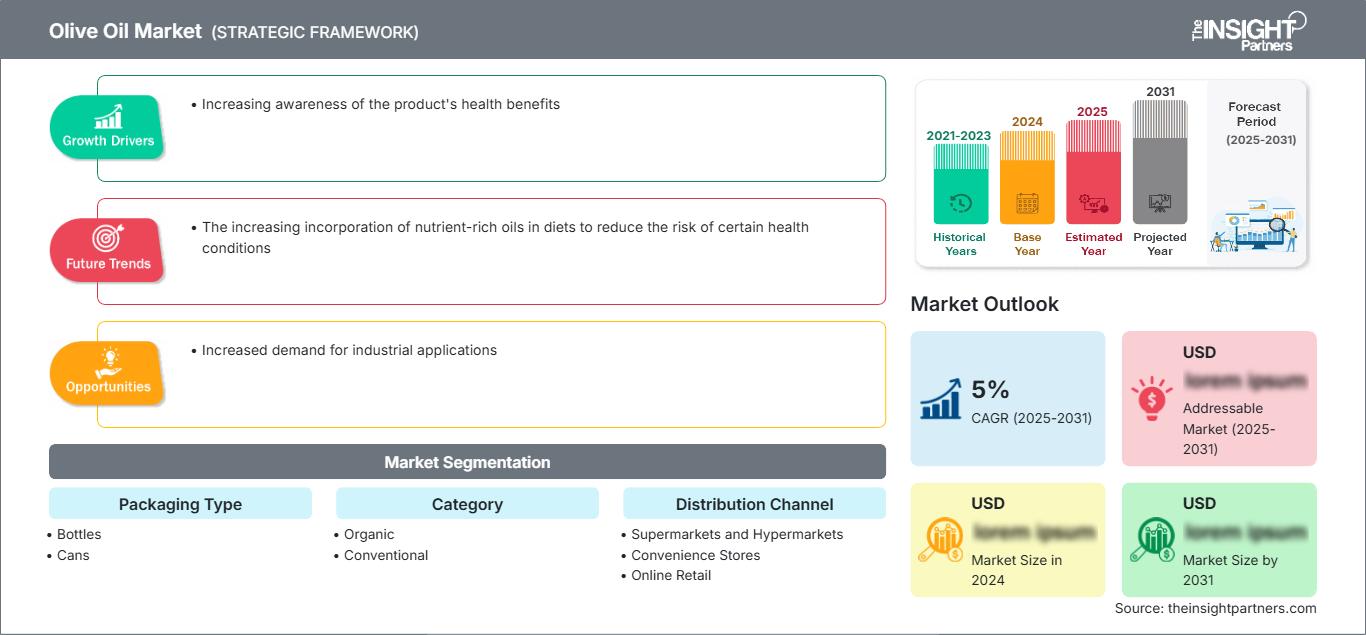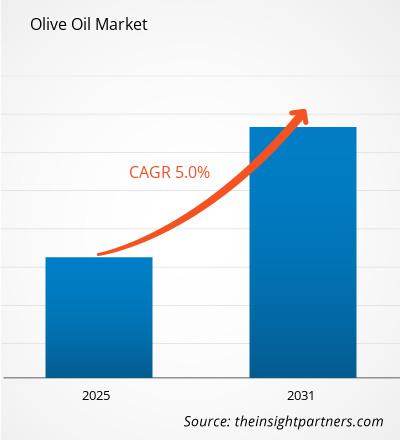Si prevede che il mercato dell'olio d'oliva registrerà un CAGR del 5% tra il 2023 e il 2031. La crescente integrazione di oli ricchi di nutrienti nelle diete per ridurre il rischio di determinate condizioni di salute rimarrà probabilmente una tendenza chiave nel mercato.
Analisi del mercato dell'olio d'oliva:
- Il mercato sta assistendo a una forte crescita principalmente a causa della crescente domanda di olio d'oliva nella ristorazione e nel settore della vendita al dettaglio.
- Inoltre, si prevede che la domanda di cucine esotiche stimolerà la popolarità dell'olio d'oliva europeo Olea in diverse parti del mondo.
- L'olio d'oliva europeo Olea è essenziale per una dieta mediterranea grazie ai suoi numerosi benefici per la salute. Si prevede che la consapevolezza di questi benefici per la salute, attribuiti al suo contenuto di acidi grassi omega-3, ne aumenterà la domanda negli anni a venire.
- La domanda di questo olio è in aumento anche grazie al suo utilizzo come ingrediente nella produzione di integratori alimentari e prodotti farmaceutici.
Panoramica del mercato dell'olio d'oliva
- L'olio d'oliva si ottiene dal frutto dell'olivo ed è disponibile come olio d'oliva vergine, olio extravergine di oliva, olio d'oliva leggero, olio di sansa di oliva e olio d'oliva raffinato.
- L'olio extravergine di oliva viene utilizzato per alimenti, prodotti per la cura del corpo e altri prodotti. È un liquido multiuso e, pertanto, è utilizzato dalla maggior parte della popolazione mondiale.
- Questo olio viene utilizzato per cucinare, nei prodotti da forno e come condimento per l'insalata. Inoltre, l'olio extravergine di oliva è ricco di antiossidanti e grassi monoinsaturi, il che gli conferisce un sapore delicato.
- Le persone attente alla salute preferiscono cucinare con l'olio d'oliva per i suoi benefici per la salute. L'olio extravergine di oliva è salutare per il cuore umano e aiuta a gestire l'obesità.
- Il mercato dell'olio extravergine di oliva svolge un ruolo importante nella cura della pelle, poiché questo olio idrata e guarisce la pelle.
Personalizza questo rapporto in base alle tue esigenze
Potrai personalizzare gratuitamente qualsiasi rapporto, comprese parti di questo rapporto, o analisi a livello di paese, pacchetto dati Excel, oltre a usufruire di grandi offerte e sconti per start-up e università
Mercato dell'olio d'oliva: Approfondimenti strategici

-
Ottieni le principali tendenze chiave del mercato di questo rapporto.Questo campione GRATUITO includerà l'analisi dei dati, che vanno dalle tendenze di mercato alle stime e alle previsioni.
- La consapevolezza dei consumatori sui benefici per la salute dell'olio d'oliva è un fattore trainante importante per il mercato. Una maggiore consapevolezza dei consumatori sui benefici per la salute dell'olio d'oliva è diventata un fattore trainante importante per il mercato.
- Con i consumatori che diventano più attenti alla salute e cercano alternative salutari, la domanda di olio d'oliva è aumentata vertiginosamente, poiché è noto per essere ricco di grassi monoinsaturi e antiossidanti e per le sue proprietà antinfiammatorie, che a loro volta sono direttamente collegate alla riduzione dei rischi di malattie cardiache e altre gravi malattie come l'ictus e alcuni tipi di cancro, così come il temuto Alzheimer.
- La ricerca in questo settore, ora positiva e diffusa in campo medico, ha trasformato l'olio d'oliva in un superalimento nella mente dei consumatori.
- Questi benefici e l'effetto alone della dieta mediterranea, che è stata sufficientemente pubblicizzata come salutare e che include l'olio d'oliva come un importante alimento base, hanno, a loro volta, incoraggiato Produttori e operatori del settore del marketing hanno sottolineato i benefici per la salute dell'olio d'oliva nelle loro iniziative di marketing. Ciò ha portato a un aumento della domanda e delle vendite in tutti i segmenti di consumatori.
Aumento della domanda per applicazioni industriali
- La crescente necessità di usi industriali rappresenta anche una grande opportunità per il mercato dell'olio d'oliva.
- Poiché produttori e consumatori globali cercano alternative naturali e più sane agli ingredienti sintetici, l'olio d'oliva viene utilizzato sempre più ampiamente in vari settori.
- In cosmetica, è apprezzato per le sue qualità idratanti e antiossidanti e viene quindi utilizzato in creme e lozioni per la pelle e i capelli.
- Nel settore farmaceutico, l'olio d'oliva viene utilizzato per formulare farmaci come vettore e per produrre integratori. Nell'industria, le sue proprietà lubrificanti lo rendono un'opzione più ecologica per alcuni processi.
- Questa diversificazione d'uso amplia il mercato per i produttori di olio d'oliva, aiuta a stabilizzare la domanda e aumenta potenzialmente il margine di profitto per i produttori nei segmenti non alimentari.
Analisi della segmentazione del rapporto sul mercato dell'olio d'oliva
L'ambito del mercato globale dell'olio d'oliva è segmentato in base al tipo di imballaggio, alla categoria e al canale di distribuzione.
- In base al tipo di imballaggio, il mercato dell'olio d'oliva è segmentato in bottiglie, lattine e altri.
- In base alla categoria, il mercato è suddiviso in biologico e convenzionale.
- In base al canale di distribuzione, il mercato è suddiviso in supermercati e ipermercati, minimarket, vendita al dettaglio online e altri.
Analisi della quota di mercato dell'olio d'oliva per area geografica
- Il rapporto sul mercato dell'olio d'oliva comprende un'analisi dettagliata di cinque principali regioni geografiche, che include le attuali e Dimensioni storiche del mercato e previsioni per il periodo 2021-2031, che coprono Nord America, Europa, Asia-Pacifico (APAC), Medio Oriente e Africa (MEA) e America meridionale e centrale.
- Ogni regione è ulteriormente suddivisa in sottosegmenti nei rispettivi Paesi. Questo rapporto fornisce analisi e previsioni per oltre 18 Paesi, analizzando le dinamiche del mercato dell'olio d'oliva, come fattori trainanti, tendenze e opportunità che influenzano i mercati a livello regionale.
- Inoltre, il rapporto include l'analisi delle Cinque Forze di Porter, che prevede lo studio dei principali fattori che influenzano il mercato dell'olio d'oliva in queste regioni.
Le tendenze regionali e i fattori che influenzano il mercato dell'olio d'oliva durante il periodo di previsione sono stati ampiamente spiegati dagli analisti di The Insight Partners. Questa sezione analizza anche i segmenti e la geografia del mercato dell'olio d'oliva in Nord America, Europa, Asia-Pacifico, Medio Oriente e Africa, America meridionale e centrale.
Ambito del rapporto sul mercato dell'olio d'oliva
| Attributo del rapporto | Dettagli |
|---|---|
| Dimensioni del mercato in 2024 | US$ XX million |
| Dimensioni del mercato per 2031 | US$ XX Million |
| CAGR globale (2025 - 2031) | 5% |
| Dati storici | 2021-2023 |
| Periodo di previsione | 2025-2031 |
| Segmenti coperti |
By Tipo di imballaggio
|
| Regioni e paesi coperti |
Nord America
|
| Leader di mercato e profili aziendali chiave |
|
Densità degli operatori del mercato dell'olio d'oliva: comprendere il suo impatto sulle dinamiche aziendali
Il mercato dell'olio d'oliva è in rapida crescita, trainato dalla crescente domanda da parte dei consumatori finali, dovuta a fattori quali l'evoluzione delle preferenze dei consumatori, i progressi tecnologici e una maggiore consapevolezza dei benefici del prodotto. Con l'aumento della domanda, le aziende stanno ampliando la propria offerta, innovando per soddisfare le esigenze dei consumatori e sfruttando le tendenze emergenti, alimentando ulteriormente la crescita del mercato.

- Ottieni il Mercato dell'olio d'oliva Panoramica dei principali attori chiave
Il mercato dell'olio d'oliva viene valutato raccogliendo dati qualitativi e quantitativi a seguito di ricerche primarie e secondarie, che includono importanti pubblicazioni aziendali, dati di associazioni e database. Di seguito è riportato un elenco degli sviluppi del mercato in termini di innovazioni, espansione aziendale e strategie:
- GOOD PLANeT Foods, nota per il suo formaggio all'olio d'oliva, ha ampliato la sua linea di prodotti con fette di formaggio nei gusti Cheddar piccante e Gouda affumicato, offrendo opzioni senza latticini con un gusto eccezionale, una buona scioglievolezza e benefici per la salute del cuore grazie all'uso di olio d'oliva. (Fonte: GOOD PLANeT Foods, comunicato stampa, marzo 2024)
- Neolea, un produttore mediterraneo, ha introdotto il suo olio extravergine di oliva in confezioni sostenibili in lattina di alluminio, dotate di un tappo "Fresh Cap" riutilizzabile per garantire l'integrità, la freschezza e il sapore dell'olio. (Fonte: Neolea, Newsletter, maggio 2024)
Copertura e risultati del rapporto sul mercato dell'olio d'oliva
"Dimensioni e previsioni del mercato dell'olio d'oliva (2021 - 2031)" fornisce un'analisi dettagliata del mercato che copre le seguenti aree:
- Dimensioni e previsioni del mercato dell'olio d'oliva a livello globale, regionale e nazionale per tutti i segmenti di mercato chiave coperti dall'ambito
- Tendenze del mercato dell'olio d'oliva e dinamiche di mercato come fattori trainanti, vincoli e opportunità chiave
- Analisi dettagliata delle cinque forze PEST/Porter e SWOT
- Analisi del mercato dell'olio d'oliva che copre le principali tendenze del mercato, il quadro globale e regionale, i principali attori, le normative e i recenti sviluppi del mercato
- Analisi del panorama industriale e della concorrenza che copre la concentrazione del mercato, l'analisi della mappa termica, i principali attori e i recenti sviluppi per il mercato dell'olio d'oliva
- Profili aziendali dettagliati
- Analisi storica (2 anni), anno base, previsione (7 anni) con CAGR
- Analisi PEST e SWOT
- Valore/volume delle dimensioni del mercato - Globale, Regionale, Nazionale
- Industria e panorama competitivo
- Set di dati Excel
Report recenti
Rapporti correlati
Testimonianze
Motivo dell'acquisto
- Processo decisionale informato
- Comprensione delle dinamiche di mercato
- Analisi competitiva
- Analisi dei clienti
- Previsioni di mercato
- Mitigazione del rischio
- Pianificazione strategica
- Giustificazione degli investimenti
- Identificazione dei mercati emergenti
- Miglioramento delle strategie di marketing
- Aumento dell'efficienza operativa
- Allineamento alle tendenze normative






















 Ottieni un campione gratuito per - Mercato dell'olio d'oliva
Ottieni un campione gratuito per - Mercato dell'olio d'oliva